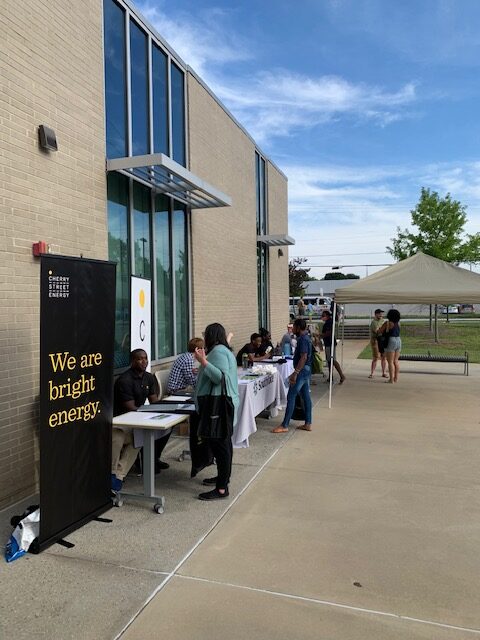Equipping vulnerable communities to navigate extreme weather, health disruptions, and other emergencies with Resilience Hubs
As the impacts of climate change mount, heightened weather and health disruptions are posed to local governments, organizations, and communities to navigate: heat waves, polar vortexes, storms... and pandemics, just to name a few.
In 2019 and preceding years, Fulton County, Georgia, was dealing with several of these disruptions, and realized they needed to enhance facilities and services to support under-resourced and vulnerable communities as they weather these proverbial - and literal - storms. They realized they needed a physical facility that was equipped to serve the needs of community members during emergencies, and also to be a place people could go on an ongoing basis to get assistance accessing and leveraging resources needed in their daily lives. In partnership with SSDN and the Southface Institute, they plotted a path toward establishing the county’s first community resilience hub.
Identifying an effective solution

Photo courtesy of Southface Institute
Relying on expertise and guidance from a USDN leader who was part of the team that developed some of the first resilience hubs in the country - in Baltimore - the Fulton County team went on an educational and informational journey to better understand the potential concept. Alex Trachtenberg, Fulton County's previous Energy and Sustainability Manager (and previously on staff at Southface Institute), delved into research on best practices across the country, which led them to the resilience hub structure.
“Our communities were dealing with a wide variety of issues, exposing and exacerbating vulnerabilities to climate risks, extreme weather disruptions, public health crises, and even displacement from development,” said Trachtenberg. “We needed to pursue concepts that would maintain and improve community assets and the resources and services we provided, particularly to under-resourced communities whose challenges are compounded by earning lower incomes, experiencing higher rates of unemployment, dealing with transportation deficiencies, and often being located in areas of high energy burden.”
Through their research, Fulton County and Southface mapped out that a resilience hub would serve two distinct but complementary purposes. First, the hub would serve on an ongoing basis as a daily community resource center. They would locate the hub in an existing, county-owned facility - a place where community members already know to go for services and programming that supports their quality of life and daily needs.
The perfect candidates to house a resilience hub would, ideally, be libraries, health centers, recreation centers, or community-based organizations that could be enhanced with additional services and operations that promote sustainability and resiliency. These centers would be expanded to provide education, training and workforce development, including basic health and medical programs, and support to guide community members through the often-complicated processes of identifying and accessing assistance programs.
Second, the hub would be a resource in times of emergency. When there’s a crisis, heat wave, storm, pandemic, or cold snap, the hub would have access to emergency power and water and food - critical survival needs. The selected facility would be equipped with resilient and sustainable technologies - solar power, battery storage, electric vehicle charging, rainwater harvesting systems, community gardens - enabling it to operate and meet basic human needs in times of emergency.
“Layering all these elements together, we created a new model of how the county and community could design, build, and operate facilities that serve the needs and priorities that our communities have both today and for the long term,” said Trachtenberg. “We know that needs will evolve over time as new health concerns arise, and extreme weather patterns worsen. We know that things are going to change, possibly getting more difficult for vulnerable communities as they encounter more risks and more crises. We need to make sure people are as prepared as possible.”
Getting the ball rolling

Photo courtesy of Southface Institute
With the grant from SSDN awarded in late 2019, project planning, building assessments, feasibility analyses, virtual community outreach and preparing for virtual community engagement sessions in light of the COVID-19 pandemic consumed the first year of the project in 2020. The team identified the most suitable candidates for the resource hub as four county facilities: two were health centers, two were libraries.
They further narrowed their search by evaluating building conditions, identifying whether they were facilities where they’d have a running start - ones that already had good energy and water practices. They evaluated the existing programs and services and community assets to determine where the resources the resilience hub would offer would be a good complement. They gauged staff and community interest in the project and receptiveness to expanding the scope of the existing facility’s offerings.
“We took great care to identify elements about each potential facility that were already tremendous assets to the community,” said Imani Love, Program Coordinator, Southface Institute. “We needed to address certain deficits, as well, of course, but we wanted to select a place where great things were already going on - where we saw recreational resources, affordable housing nearby, restaurants, businesses, and access to public transportation like MARTA. Finding a facility that had existing, helpful assets was important to the project’s success.”
The team also conducted a robust community engagement and outreach process to get input on community needs and priorities to improve resiliency and facilitate participation in codesigning the hub from those who might ultimately be using it. Aggregating this input, reviewing analyses and assessments, community assets and vulnerabilities, the Metropolitan Branch Library in Southwest Atlanta was selected as the location for the first Fulton County resilience hub.
Developing a resilience hub during a pandemic
Just as the project kicked off in earnest in March 2020, COVID-19 lockdowns were issued, and local governments were pulled in several directions to address the acute impacts of the pandemic on communities and county operations. While challenging the availability of resources and impacting the project’s plan and timeline, it also underscored the need for precisely this type of community resource.
A critical element of the early development phase was intended to be in-person visioning and education sessions with community members to build relationships and collect input on needs and priorities across the various layers of a resilience hub, but the team was forced to pivot from that approach and rethink the engagement strategy altogether. Instead of in-person meetings, online engagement tools like video conferencing and digital whiteboarding were leveraged, and a lot of effort went into making online platforms engaging and fun in order to get the essential community feedback needed for the project to be successful.
While community input was gathered, Southface Institute engineers got to work analyzing and assessing the Metropolitan Branch Library’s facility, conducting energy and water efficiency assessments. American Microgrid Solutions with support from The Clean Energy Group were brought in to assess the feasibility of solar and battery storage options. Georgia Water Tanks and Wood PLC conducted an analysis and design of rainwater harvesting configurations, and provided ideas for how to best implement those aspects.

Photo courtesy of Southface Institute
Making connections with existing community networks to help with fundamental outreach and education efforts was challenging during a pandemic, as well, but much was able to be achieved through online interactions. Working with neighborhood planning units (NPUs) - groups affiliated with the local planning department to review zoning and permitting applications - neighborhood associations, nonprofits and community organizations they established a forum to talk about the variety of issues the communities were facing: safety, infrastructure, transportation, housing. The community groups were leveraged to get info out to community members. The objective was clear: we want to hear from you, participate and partner with you throughout this process because this initiative is intended to serve you, your communities, your families. As the education effort progressed, they started building relationships, building contacts, building trust.
To encourage participation and give back to the community, grocery gift cards and smart thermostat giveaways were promoted, and engagement was strong. And as the pandemic restrictions eased during the summer of 2021, people came together in person once again during pop-up engagement sessions at each of the candidate sites, learning about the purpose of the resilience hub, providing items from resilience kits, collecting additional input, and becoming more educated about the importance and practical application of sustainability, resiliency, equity and justice.
“Getting the feedback of those who would benefit from these services and who know their own communities better than anyone else ever could was perhaps one of the most valuable inputs to this project,” said Trachtenberg. “Community input was used to refine and iterate on our initial plans, allowing us to design a hub that most meaningfully met the needs of the people who would use it.”
Preparing to serve the community
Final design and implementation plans of battery storage, rainwater harvesting, electric vehicle charging, community garden, programming and services, and operations are underway, and the Metropolitan Branch Library’s resilience hub is on track to be up and running by the end of 2022. Solar panels have already been installed on the facility, leveraging a separate county program through a favorable solar energy procurement agreement with Cherry Street Energy. In fact, solar panels have been installed on all four of the sites that were candidates for the resilience hub.
At the Metropolitan Library, Georgia Power and the county are partnering on site electrical infrastructure to be able to charge six electric vehicles at one time, with the county funding the stations and Georgia Power funding the prep through their “Make Ready” program.
Post-COVID supply chain issues have impacted the timeline and the budget, but Fulton County, Southface Institute and its partners are optimistic about staying on track.
“The joy in this project has been being able to work with and really get to know more community organizations better, creating more pathways to community cohesiveness,” said Love. “Diving in and doing the hard work to understand what the community really wants and needs, interacting one-on-one with people, was helpful and rewarding. Hopefully, the success we achieve through this resilience hub will spur other projects like it that will help more Georgians and expand to more states and communities across the country.”

